Alex Israel: Reimagining Los Angeles
|ANNELI BOTZ
It’s a warm and sunny December afternoon in Los Angeles, California, the kind of day where the city’s iconic skyline gleams under the clear blue sky. At that moment, there is no sign of the devastating fires that would soon sweep through the region and change the landscape of the city. A city that artist Alex Israel holds close to his heart, both as his hometown and as a continual wellspring of inspiration.
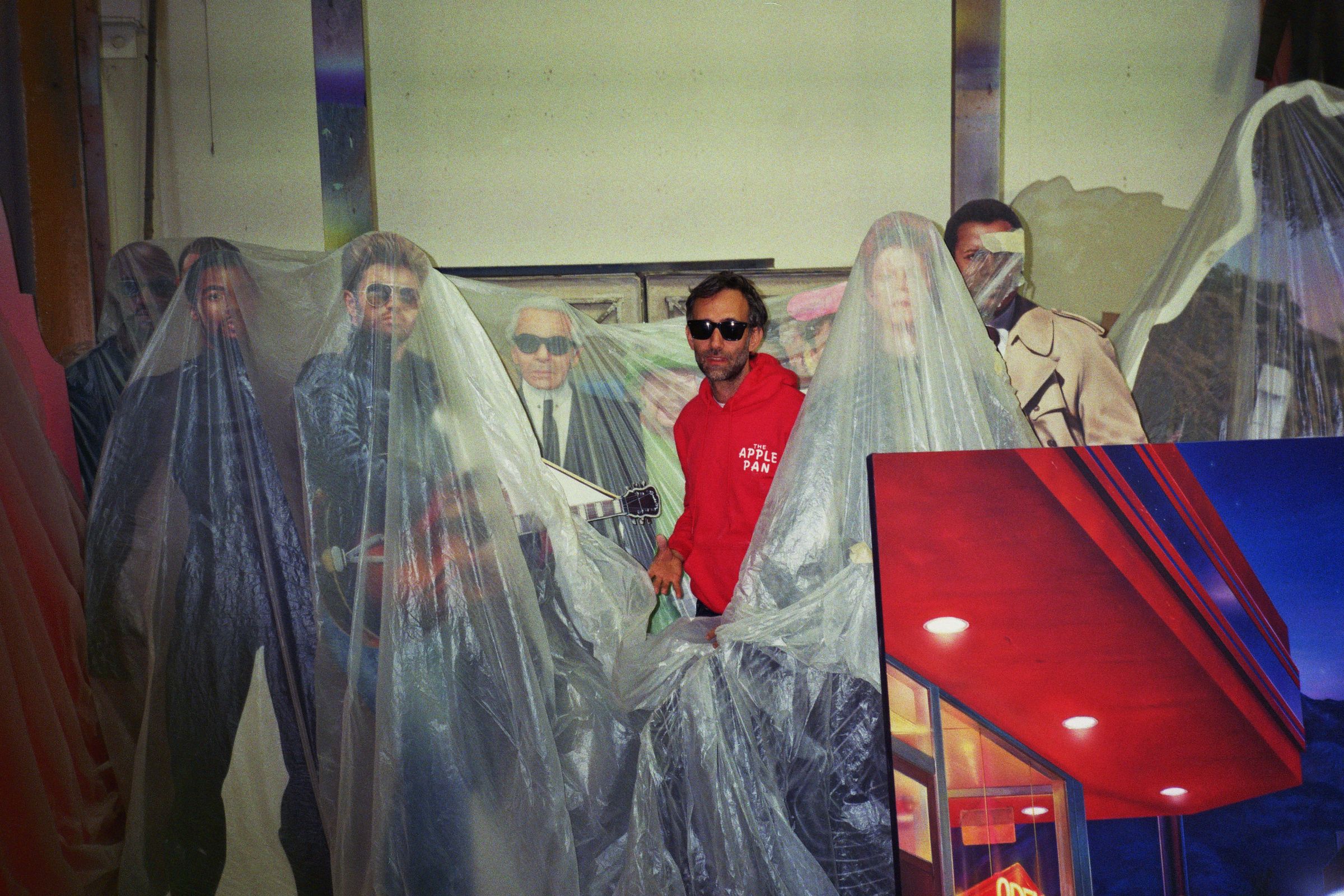
Alex Israel portrait. Photo: Anneli Botz
Over the past decades, Israel’s colorful and playful work has been deeply influenced by the iconography of Hollywood, the complexities of identity, media, and the pursuit of the American Dream. Fittingly, his studio is situated in one of Hollywood’s landmarks, Warner Bros. Studios, where he has a dedicated space for his paintings and other projects in the scenic department. The iconic setting couldn’t be more fitting.
His new body of work, “Noir,” explores the city in a more quiet, mysterious way. Inspired by the film genre and long walks through Los Angeles at night, the artist depicts personal landmarks—an old diner, a frozen yogurt shop, a gas station. His highly saturated images are imbued with his own iconography. They feel like frozen frames pulled from a movie, leaving the viewer to wonder what came before and what might happen after
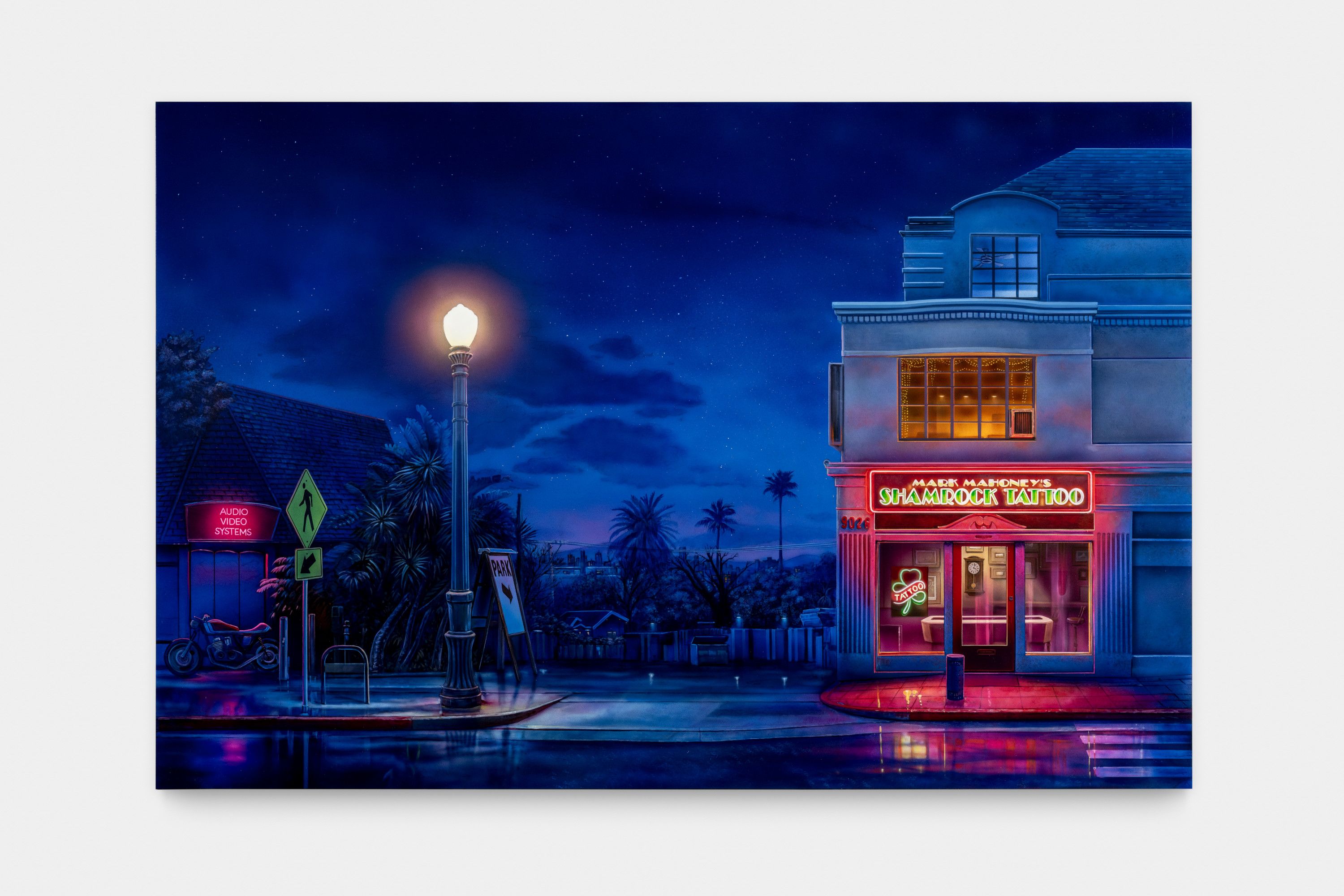
Alex Israel, Shamrock Tattoo, 2024. Photographed by Josh White. Courtesy the Gagosian
ANNELI BOTZ: In the paintings for your show “Noir,” the absence of people stands out. It adds to a feeling of intimacy, loneliness, and mystery. What brought you here?
ALEX ISRAEL: I think a lot changed for me during the pandemic. I spent a lot of time walking around LA, daytime and nighttime. The city was often empty and there were moments when I felt like I had it all to myself. I became more focused on its details, seeing things on my walks, looking at things at a much slower pace than if driving by.
Recently, I wanted to make images of Los Angeles that don’t feel like anything I’d already seen or that I might come across in an Instagram feed. And I wanted them to express my own experience of this place, my emotional connection to it, and a certain mood. This desire brought me to the idea of noir.
AB: Which is a film genre.
AI: Yes, it’s an art form that was invented here in Los Angeles. Noir is all about questioning established systems of morality. In any noir, there’ll be elements of corruption and confusion, of characters being deceived or backstabbed. Noir asks what it means when you’re up against a power that is stronger than justice, when good doesn’t prevail over evil. And this theme of destabilization, of questioning what we think we know to be true or real or good, bleeds into so much of what we’re experiencing in culture right now, and perhaps where we’re going—a forthcoming era of AI, sans fact-checking. It’s a theme that’s relevant to both the history and culture of LA, and to the culture as it exists today.
AB: I remember noir films being quite stark in their use of light and darkness. Do you feel like you translated that into the like exaggeration of color?
AI: The paintings I’ve made aren’t black and white. There’s no light seeping into the room through classic venetian blinds. They represent my own interpretation of the genre, and what noir might look like as filtered through the visual language of our moment: colorful and saturated video game imagery, animation and AI-generated imagery. These are forms we use today to explore the relationship between reality and fiction, and they’ve provided me with a new lens through which I can describe the city.
I worked with an animator to create each of the “Noir” images as a sort of anime or video game backdrop, based on my memories, my photos, and drawings. These digital renderings were then translated into paintings here at Warner Brothers, in the studio where the famous and arguably first noir film, The Maltese Falcon (1941), was filmed, less than—I don’t know—one hundred yards from where we’re painting.
AB: Is it true that scenic art as we see it here in the studio is a dying craft?
AI: It’s almost extinct. The only scenic painting department left at any major Hollywood Studio is right here at Warner Brothers. And it only exists, really, because of my artwork, because we occupy this space and are keeping this craft alive.
So not only is there a sense of longing and nostalgia in these works, which is enhanced by the lighting and the stillness of the images, there’s also the reality that we are barely hanging onto the scenic painting tradition, to the analog form by which they are made. Scenic painting is a Hollywood tradition that potentially dies when either I stop making paintings or Andrew Pike, who is the last painter here, retires. These works are very much aware that they’re at the end of this legacy.
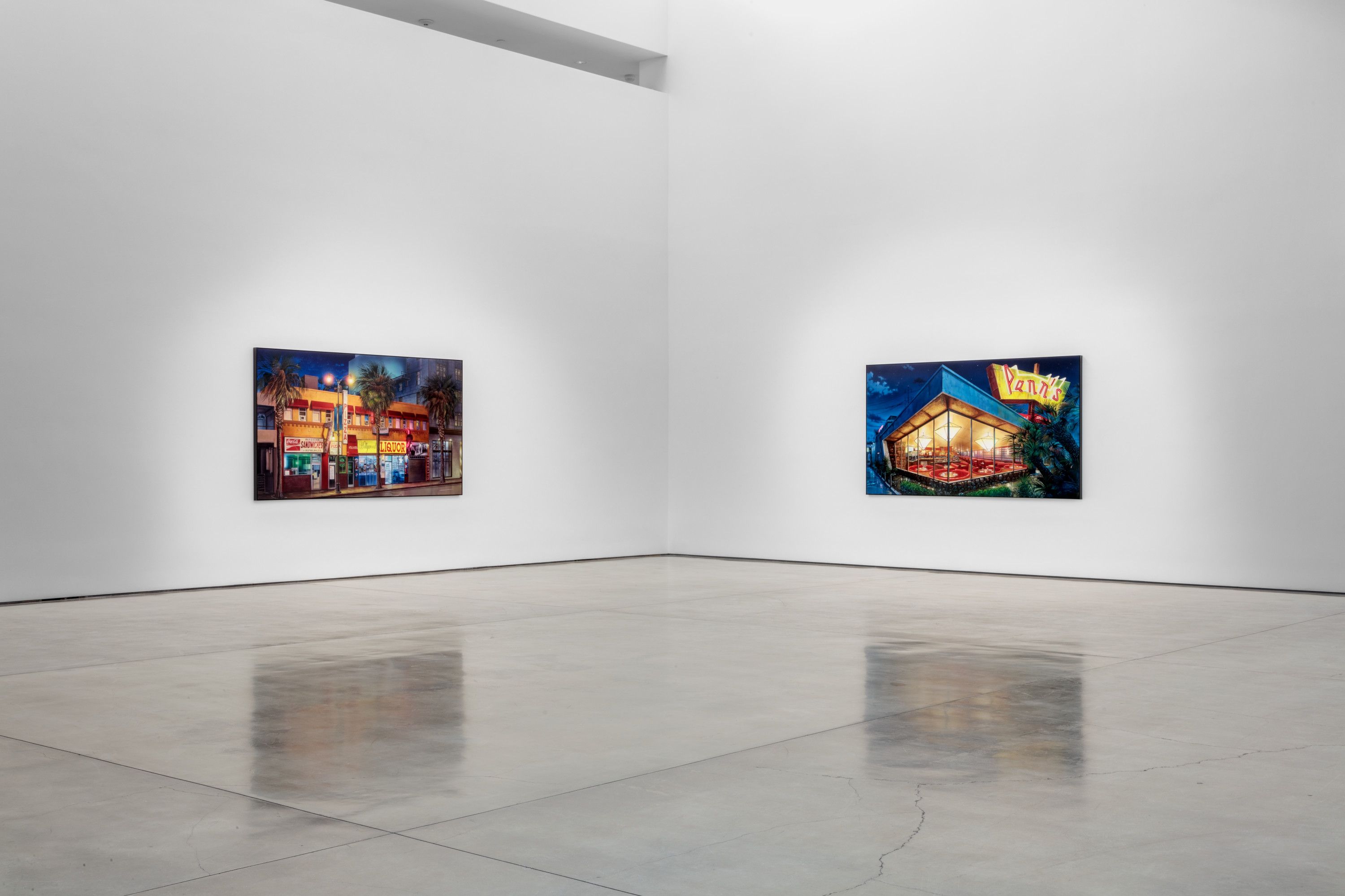
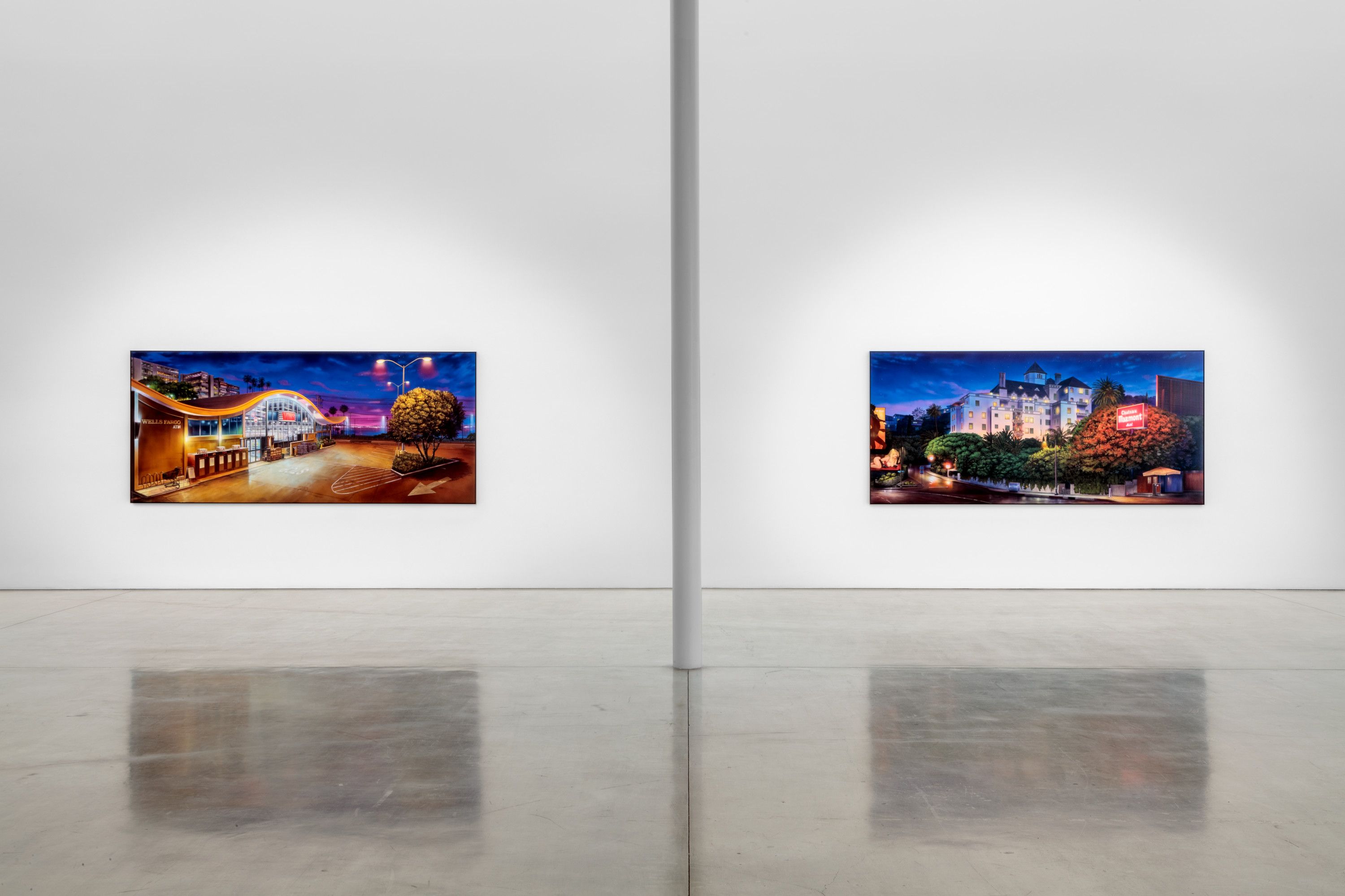
Installation views of Alex Israel, "Noir", Gagosian, Los Angeles, 2025. Photography: Charles White. Courtesy Gagosian
AB: The paintings have the aesthetics of an anime backdrop but built upon the language of a bar scene by Edward Hopper.
AI: Hopper’s vision has always been deeply inspiring to me because it’s so American and so cinematic. He established a visual language to describe our country that has seeped into popular culture and become embedded into our collective understanding of what American life looks like. The other artist that was a big inspiration on this body of work is Ed Ruscha. Ruscha was of course very influenced by Hopper.
AB: Hopper always made a point through the quietness of his images.
AI: Yes, and they invite narrative interpretation without ever spelling it out. They establish the location without sprinting out the action. The form of background anime is similar, it exists so that some action can be performed on top of it.
AB: And then with Ed Ruscha, I think it’s less about the narrative.
AI: His work captures LA’s ethos and defines a visual symbology of city: its signs, its commerce.
AB: Alfred Hitchcock was also very much inspired by Hopper and by the idea of the voyeuristic angle, the observational element.
AI: That voyeuristic element exists in a few of these paintings: Troubadour, Shamrock Tattoo, and Hollywood Liquor. You, as the viewer, can peer into the apartments and offices above street level and look for signs of life. You won’t find any characters up there, but you can certainly imagine them.
AB: Is there also an element of preservation in it all, of the places you knew, that might change in the future?
AI: The city’s constantly changing. You can never really take the same picture twice. In constructing each image, as a basis for each painting, I merged my memory of a place with what you might call its more literal description. The paintings aren’t photorealistic, and many of their elements don’t mimic an objective reality. I’ve taken a lot of liberties to distort things, to skew them towards my memories and idealizations of these places.
AB: One of the paintings shows a frozen yogurt shop, which used to belong to your dad, I believe.
AI: Yes, my dad used to own it when I was in grammar school, and I went there every day after school. We used to go to a lot of Laker games as a family, and we’d always go to Pann’s either before the game for dinner or after the game for dessert. Pann’s is the diner in another painting.
AB: While these paintings show no characters, there is in fact a lot of portraiture in your work. Self-portraits, people portraits, you did a whole TV show portraying people.
AI: I make portraits. I make landscapes. Maybe I’m a genre artist? Although my Self-Portraits occupy a less traditional portraiture space, because they were more about branding myself than they were about capturing my likeness.
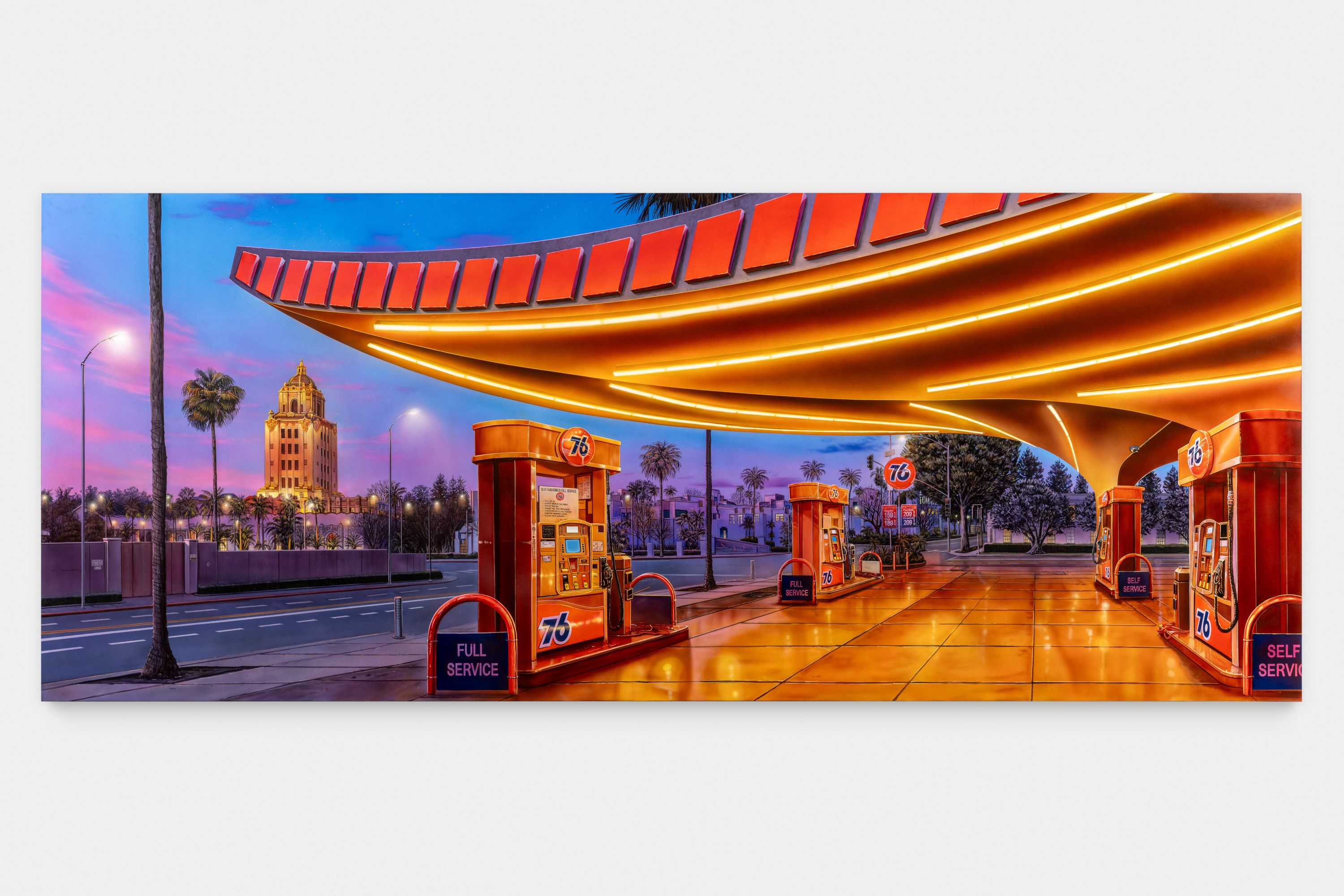
Alex Israel, Gas Station, 2024. Photography: Josh White. Courtesy Gagosian
AB: You created a TV show-inspired YouTube format As it Lays, of which you’ve made 66 episodes. The setup is simple: You interview celebrities, the topics are never about their career, and you never ask follow-up questions. You wear the same suit each time and you deliver the role of the host in a deadpan voice, completely unfazed. Your last question is always: “What do you want the world to know about [subject’s name]?” I found that it becomes more and more interesting the more episodes you watch, through the repetition of its format.
AI: Seriality and repetition are important aspects of the project. Where at first watch I might seem awkward or strange or stiff, the fact that I wear the same outfit, speak in the same way, and engage in the exact same way with every person makes me predictable, reliable, less focal. When you watch multiple episodes, I become increasingly invisible. I become a framing device for the subjects, part of the context from which their portrait emerges.
AB: The title for the show was inspired by an iconic novel by Joan Didion. I remember that Joan Didion also describes in one book how her character drives the same street in LA—I think its Mulholland Drive—every day. She makes a point out of how the mode of repetition gives her character structure and safety.
AI: I walk around the same neighborhood every day. Repetition definitely informs your thinking about a place. Of course, the more time you spend with something, the more you sort of understand it. And that’s LA to me. What do you know better than the place you’ve lived in your whole life?
And aside from LA, the other thing I’ve known and studied my whole life is popular culture. As a kid, I watched movies and television shows and cartoons and went to amusement parks and pop concerts. My parents didn’t work in entertainment, but there were Hollywood people we knew from school and from trick-or-treating on Halloween. LA’s entertainment culture was likewise a very natural subject for me to gravitate towards when I started thinking about how to find my voice as a creative person.
AB: The one episode of As it Lays with Marilyn Manson really cracked me up. He is hilariously inappropriate. Every person you interview reacts so differently, some really go with your style, others make it their own.
AI: So, I have one job when conducting those interviews, which is to read the questions. I stay focused on that. What did Hitchcock say about actors being like cattle?
AB: As in objectifying them?
AI: Yes. The people in As it Lays, myself included, become objects or props.
AB: And then in other works of yours the props become the characters, right? I remember your first show in Berlin, “Property.” It was a showcase of readymades, objects on pedestals, a swan, an old bicycle. Props you rented from the Babelsberg movie studios.
AI: That’s wild you saw that! That was in 2011.
AB: I was quite young then.
AI: Me too, in my 20s. Yes, for my series “Property,” I rented movie props and presented them as sculpture. Similarly, each human subject takes on the role of becoming an object in As it Lays.
AB: And ever since the props have been promoted to characters, I also remember a dancing avocado as part of your augmented reality project with Snapchat.
AI: I see the props as inanimate actors.
AB: And you give them some soul.
AI: Well, they already have it. I just select them based on how much of that soul emanates from them, as they sit there on the shelf in the prop house. Some objects have more star quality than others.
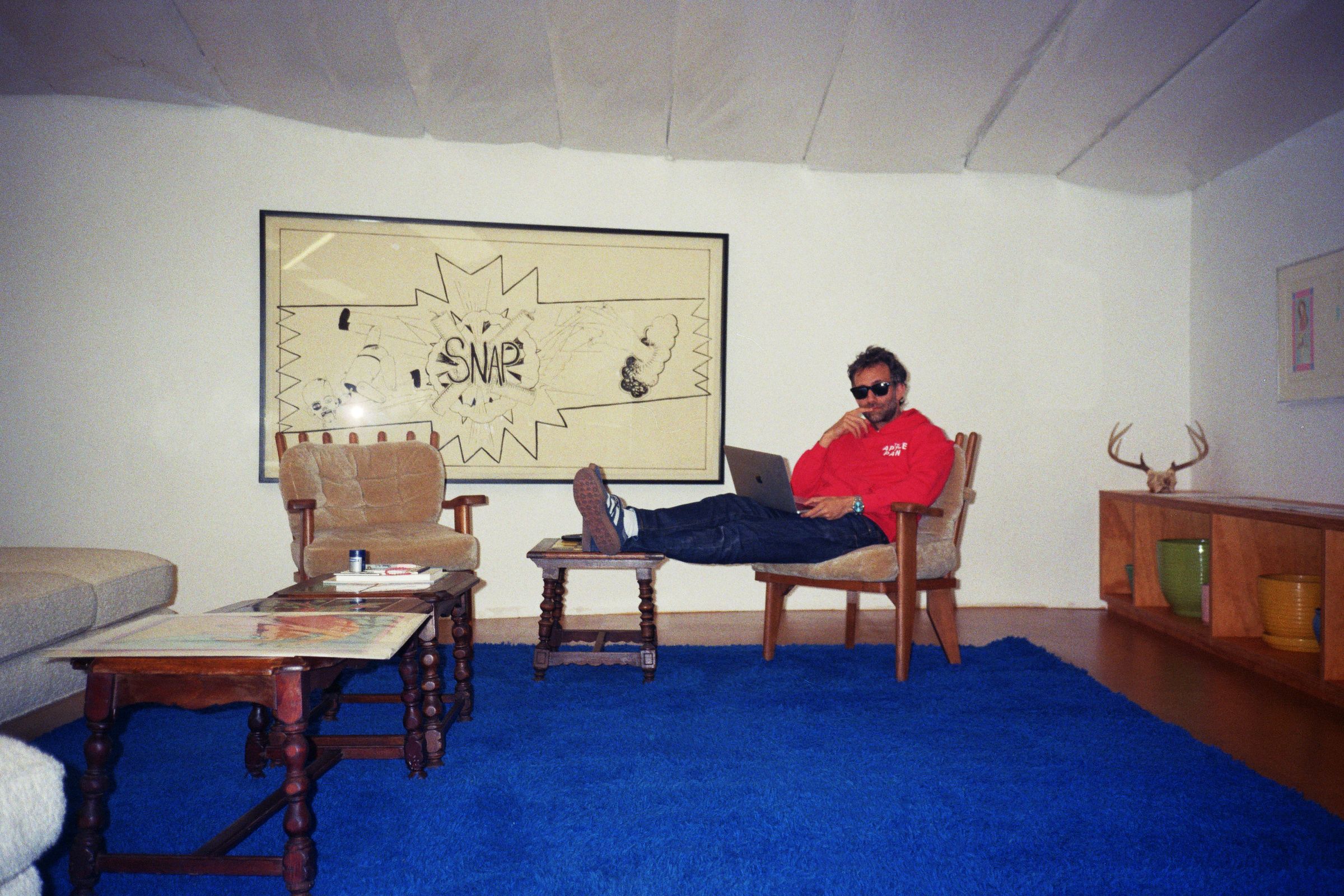
Alex Israel portrait. Photo: Anneli Botz
AI: And upon selecting them, sometimes I’d install them in front of my Flats or Sky Backdrops, and they’d get to perform, on pedestals and in an exhibition space, they get to perform as sculpture.
The ideas of foreground and background, and of performer and stage, have always been core to my practice. And the emphasis on that formal device comes from this place, from Los Angeles. People here are in a constant state of performance, and LA is the backdrop. Beyond this city, Instagram is the stage, and every post is the performance. It’s like Shakespeare, and all the world’s a stage.
AB: Can you relate to the inanimate role of the props in your role as an artist?
AI: Yes, there’s something about the structure of the art world that sometimes allows me to exist as a kind of readymade artist. That it’s my purpose, as some kind of vessel, to highlight what’s already there. I used to make sunglasses because they’re useful, non-precious, and very LA, but also because I liked the notion of literally giving people a frame and lenses through which they could see the world as it was.
And I always loved that quote from Michelangelo about how the sculpture was already there, embedded in the marble, and he was just revealing or releasing it. It’s a humbling idea and not so unlike the notion of “producing” a readymade.
The myth of LA, film noir, the scenic painting department at Warner Brothers, the diners, nightclubs, and other locales: this is all already out there. Maybe it’s just my job as an artist to point to it.
AB: Do you feel your priorities are still the same as when you started your career back in 2011?
AI: At that time, I was fresh out of graduate school. I had recently worked in galleries, at an auction house, at a museum, and for other artists. I’d encountered a number of artists who all expressed frustration that they’d somehow ended up in a corner, more or less forced by external pressures to create the same signature, marketable thing over and over again. This truly terrified me, and so when I started my career, I wanted to ensure that I’d escape this fate.
Because I was of a generation that had access to the internet as a high school student, because information about anything was relatively easy to access, and because making things had become more facile than it had been in the past, I truly felt, at that time in my life, that all creative potential was unlimited.
As a graduate student, I said to myself, “I’m going to do many kinds of things. I’m not going to end up in a corner.” And I used the internet to help me do so. I made sunglasses. I made objects for galleries. I made videos and put them on the internet. Eventually I made my movie, which I licensed to Netflix. Then there were my projects with Snapchat using augmented reality—that dancing avocado you mentioned earlier—and my exploration of AI in a more recent project: REMEMBR. And of course, all the while, I’ve continue to make art objects for exhibitions and products for luxury brands.
AB: You doubled down on the liberty to create many different things.
AI: When ideas come to me, they come as ideas. And if I want to pursue them further, I’ll then think about the best forms for them to take. I hope never to be burdened by having to create within a formula. That’s my idea of artistic freedom: the freedom to inhabit all varieties of forms and contexts.
AB: Which is huge.
AI: Heavily aided by social media, because Instagram really allowed me to collect and share so many different kinds of things and projects in a single, simplified platform.
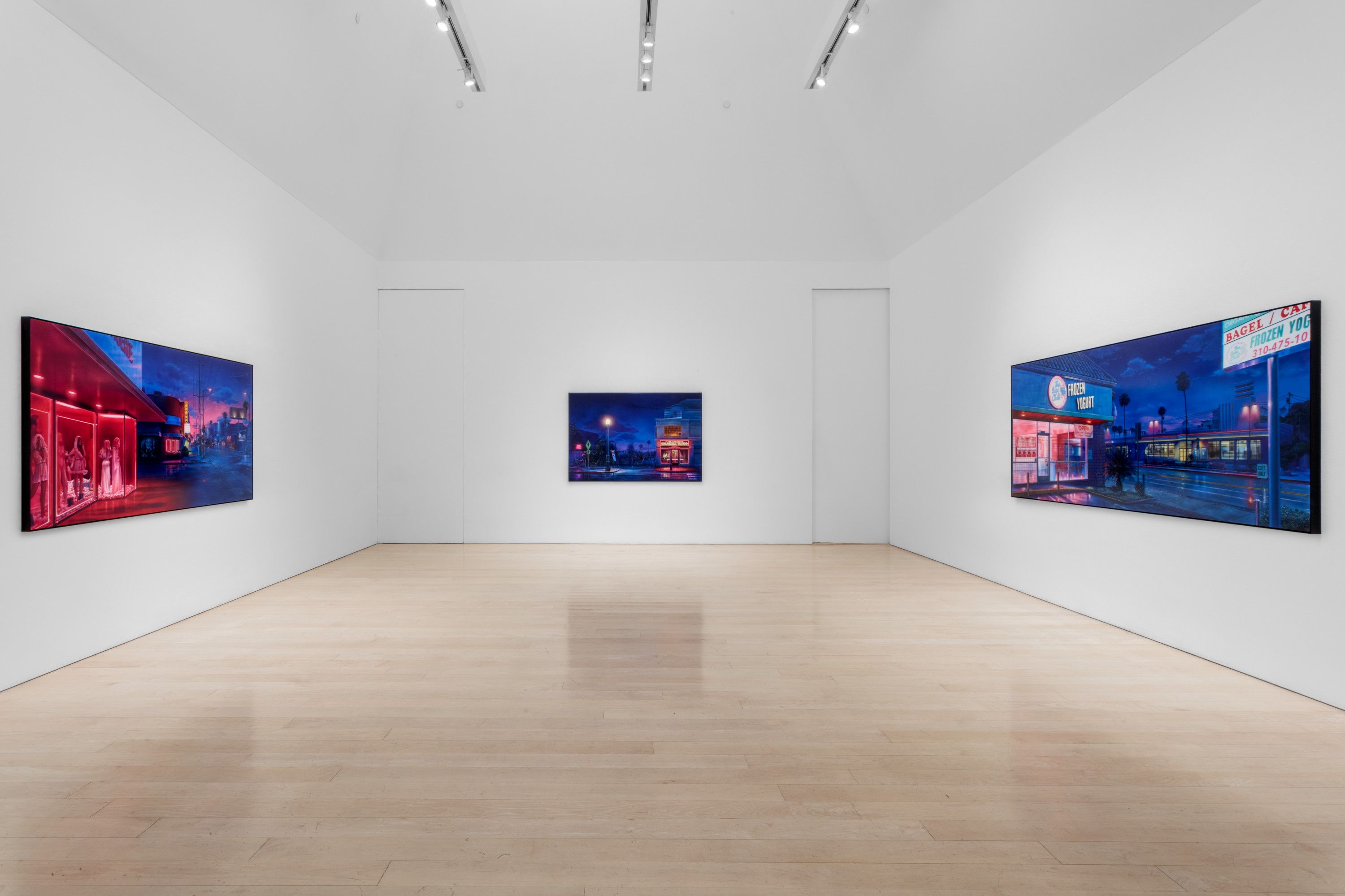
Installation view of Alex Israel, "Noir", Gagosian, Los Angeles, 2025. Photography: Charles White. Courtesy Gagosian
AB: Do you feel that there was a different excitement to the internet when everything was new?
AI: Yeah, and it’s a challenge to make things using new technology that feel eternal or potent beyond those moments. On the flip side, it’s also an interesting challenge to try to make things that are extremely of those moments. I tend towards the second path, to do my best to reflect the time that we’re in.
AB: There is a strong element of youth culture throughout the work—from the MTV aesthetics back then to social media and teen movies now.
AI: A lot of artists say they only make art for themselves. You hear this mantra in a lot of interviews and artist talks. I’ve never sympathized with that sentiment. I think about audience all the time, and especially about a younger audience. I was just at this panel discussion the other night at the GRAMMY Museum, and there was this extremely successful songwriter, who had written songs for Miley Cyrus and Rihanna. He said that one of the things he’s noticed about pop music hits is that they often speak to a third grade—nine- or ten-year-old—sense of humor.
And then he started rattling off examples of lyrics that are things that third graders would find interesting or funny. And it was all the hit songs that you could imagine “I want to hold your hand” or “Under my umbrella” or “That’s that me espresso”—these are things that a third grader understands just as well as anyone else. I’m not often thinking about my work’s resonance for a third grader, but I am thinking about my high school self. High school is when I started to understand the power of art, whatever that meant to me at that time. And I do want to communicate to high school teens through my work, to include them in it and to exist in their channels. I’m interested in teen culture and how it changes because it’s a way of understanding our future. I like to look at what the next generation is doing, how they think, and what they’re attracted to. I consider how I might support their interest in and embrace of art, to encourage its positive role in that future.
AB: As an artist so deeply devoted to the city of LA, what is your quintessential take away of its identity?
AI: I always say the thing that I love the most about LA is that it’s a place where anybody can come and recreate themselves, reinvent themselves, and become the person who they truly want to be.
That’s an incredible thing, that opportunity, and it aligns with the American dream. And even though not everybody can achieve that dream of celebrity or fame or fortune, it still exists as a possibility. No matter how cynical you are about the success rate of these transplants who come here to achieve the almost impossible, there’s still a chance. We see the dream come true every time a star is born.
ALEX ISRAEL
Noir
February 6–March 22, 2025
GAGOSIAN
456 North Camden Drive, Beverly Hills
Credits
- Text: ANNELI BOTZ